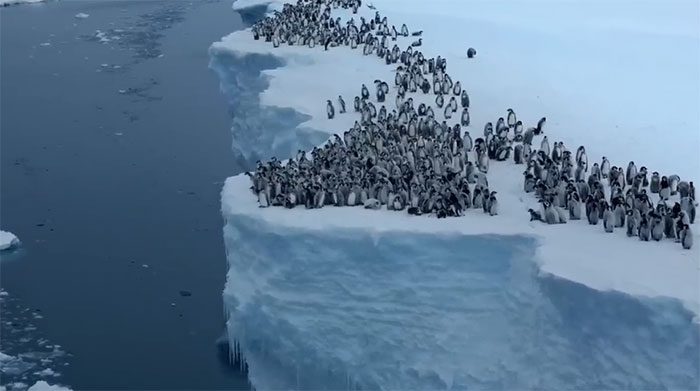The first footage captured by scientists shows more than 200 young emperor penguins jumping in succession from a 15-meter-high ice cliff to reach the sea in search of food due to extreme hunger.
A group of young emperor penguins jumping off a steep ice cliff. (Video: National Geographic).
This unprecedented footage, filmed with a drone in January 2024, captures a rare event that may become more common as sea ice diminishes, forcing penguins to adapt, according to National Geographic. Much like a group of teenagers gathered at the edge of a cliff waiting for the bravest one to jump first, hundreds of emperor penguins just a few months old congregated at the top of a 15-meter-high Antarctic ice shelf. Driven by hunger, the young birds peered over the edge of the ice cliff, seemingly contemplating whether they could survive the fall from such a great height. Then, one of them took the lead and jumped.
Some young penguins craned their necks to watch their peers drop straight down and splash into the freezing waters below. Seconds later, the brave bird surfaced and swam away to fill its belly with fresh fish, mollusks, and squid. Gradually, more young penguins followed suit, leaping down and flapping their wings to navigate the water’s surface.
The filmmakers behind the documentary “Secrets of the Penguins” recorded this rare sighting with a drone over Atka Bay at the edge of the Weddell Sea in West Antarctica. This is the first footage of young emperor penguins jumping from such a high cliff, according to scientists.
“I can’t believe they captured this moment on film,” said Michelle LaRue, a conservation biologist at the University of Canterbury in Christchurch, New Zealand. LaRue had previously visited Atka Bay to advise the film crew on documenting the behavior of emperor penguins, from egg-laying to chick-rearing.

Young penguins watching their peers drop straight down and splash into the freezing waters below.
Typically, emperor penguins nest on drifting sea ice, which melts away each year, rather than on ice shelves attached to the land. However, recently, some populations have started nesting on ice shelves. Scientists speculate that this change might be linked to sea ice melting earlier due to climate change. The International Union for Conservation of Nature classifies emperor penguins, with an estimated population of 500,000, as vulnerable, primarily due to climate change affecting their habitat.
In early January 2024, during the final weeks before the sea ice breaks up at the end of summer in the Southern Hemisphere, filmmakers encountered a group of young penguins that LaRue suspected were likely raised on the ice shelf north of the cliff. Curious about where they were headed, they maneuvered a drone to observe from above. Gradually, more young penguins joined the group until about 200 stood at the top of the steep ice cliff.
Gerald Kooyman, a physiologist who has spent over five decades studying emperor penguins in Antarctica, shared that he had only witnessed a similar event once over 30 years ago. Peter Fretwell, a scientist from the British Antarctic Survey who has studied satellite images of the penguin population in Atka Bay for several years, occasionally sees penguin tracks heading north toward the cliff. He speculated that in January, young penguins were following one or two adult birds that had taken a wrong turn.
Young emperor penguins typically jump from sea ice into the water from heights of less than one meter. However, the young birds at Atka Bay found themselves in a precarious position to enter the water while feeling extremely hungry. Their parents had swum out to sea, and it was time for them to fend for themselves. The young birds were waiting for their waterproof feathers to grow in, replacing their downy feathers.
Scientists do not believe that the act of jumping from the ice cliff is directly related to climate change warming Antarctica. However, Fretwell noted that the reduction of sea ice on the continent forces more emperor penguins to breed on ice shelves, thus such behavior is likely to become more common in the future. Scientists are concerned about the sudden decline in Antarctic sea ice since 2016 and its implications for the long-term survival of penguins.
LaRue remains hopeful about the penguins’ adaptability. “They are incredibly resilient. They have survived for millions of years, witnessing many different changes in their habitat. The key question is how quickly they can respond to the ongoing changes,” LaRue said.




















































